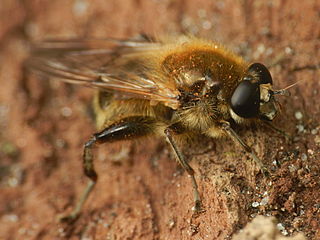
Spilomyia sayi, the Four-lined Hornet Fly, is a fairly common species of syrphid fly. This species is found from western Canada to northeastern North America. Hoverflies get their names from the ability to remain nearly motionless while in flight. The adults are also known as flower flies for they are commonly found around and on flowers, from which they get both energy-giving nectar and protein-rich pollen. The larvae are known as the short-tailed larvae, suited for moist areas such as rot holes of trees. It is a wasp mimic.

Criorhina is a genus of hoverflies. Medium to large sized species, black or greenish black, with or without light ground markings mimicking bumblebees. The head is much flattened and broader than the thorax. The antennae are situated upon a prominent conical frontal process, The face is moderately produced below the eyes, downward or forward, in profile. The eyes are bare. The abdomen is elliptical or very short oval. Larvae found in rot holes or decaying hardwoods

Chalcosyrphus is a genus of hoverflies in the subfamily Eristalinae. Many species exhibit some degree of mimicry of various sawflies and other hymenopterans and are often brightly coloured or metallic in hue. The adults are similar in structure and behavior to the related genus Xylota but differ in larval morphology. They can be found throughout Europe, Asia, and North America and seem to prefer damper, boggy habitats. The larvae are saproxylic feeders in rotten wood in these habitats.

Brachypalpus is a genus of hoverflies, from the family Syrphidae, in the order Diptera. The head is triangular and produced well forwards and somewhat downwards. The thorax and abdomen with pile often rather long. The hind femur is swollen and with an obtuse spur apically and ventrally. The hind trochanters of male is spurred.
The larvae are of the rat-tailed type feeding on decaying sap under tree bark. Larvae live in decaying trees and logs. Larva and pupa have been described by Malloch.

Tropidia is a genus hoverflies, from the family Syrphidae, in the order Diptera.

Pterallastes is a genus of bee-mimicking hoverflies. So far the genus contains only two species, one in North America and one from the Sichuan province of China.

Teuchocnemus is a genus of North American flower flies.

Somula is a genus of syrphid flies in the family Syrphidae. There are at least two described species in Somula.
Milesia bella is a species of hoverfly in the family Syrphidae.

Sphecomyia is a genus of hoverfly in the family Syrphidae. There are about 16 described species in Sphecomyia.
Criorhina nigriventris , the Bare-cheeked Bumble Fly, is an uncommon species of syrphid fly observed across the northern United States, the Appalachian Mountains and southern Canada. Hoverflies can remain nearly motionless in flight. The adults are also known as flower flies for they are commonly found on flowers, from which they get both energy-giving nectar and protein-rich pollen. The larvae of this genus are found in decaying wood.
Criorhina tricolor is a species of hoverfly in the family Syrphidae.

Spilomyia alcimus, the Broad-banded Hornet Fly, is an uncommon species of syrphid fly first officially described by Walker in 1849. Hoverflies get their names from the ability to remain nearly motionless while in flight. The adults are also known as flower flies for they are commonly found around and on flowers, from which they get both energy-giving nectar and protein-rich pollen. The larvae are known as the short-tailed larvae suited for moist areas such as rot holes of trees.
Lejota is a genus of syrphid flies in the family Syrphidae.
Blera johnsoni is a species of hoverfly in the family Syrphidae.
Xylota nebulosa is a species of hoverfly in the family Syrphidae.
Neoascia distincta is a species of Hoverfly in the family Syrphidae.
Sphegina albipes is a species of hoverfly in the family Syrphidae.
Sphegina bridwelli is a species of hoverfly in the family Syrphidae.

Sphegina infuscata is a species of hoverfly in the family Syrphidae.










